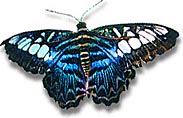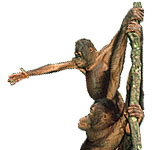This endlessly varied environment also shelters a host of the world's rarest and most remarkable animals: the Sumatran Rhinoceros, the Clouded Leopard and Malaysian Tiger, the Sun Bear, the Monitor Lizard, and the Orang Utan, or "man of the forest," are just a few examples. Malaysia's forests are also home to Southeast Asia's highest peak, as well as to the world's most extensive and capacious natural caverns. The forest itself is one of the most ancient on the planet, far older than the equatorial forests of the Amazon or the Congo. It has for tens of thousands of years been the home of nomadic forest peoples,  and ancient civilizations have flourished as well as disappeared in its vastness. Legends abound, and archaeologists have only just begun their efforts here. Equally exciting discoveries are now being made by genetic biologists, who have begun searching the wealth of life in Malaysia's forests for new medicines with which to combat AIDS, cancer, and many other illnesses.
and ancient civilizations have flourished as well as disappeared in its vastness. Legends abound, and archaeologists have only just begun their efforts here. Equally exciting discoveries are now being made by genetic biologists, who have begun searching the wealth of life in Malaysia's forests for new medicines with which to combat AIDS, cancer, and many other illnesses.
And that is only the forest. Malaysia's offshore islands are of legendary beauty. For millenia, Pulau Langkawi and Pulau Tioman have been sought-after havens of peace from the turbulent outside world, a tradition that is evidenced today by their international status as holiday destinations. Pulau Sipadan, a small oceanic island off the eastern shore of Borneo, rises in a sheer column more than six hundred meters from the seabed. Completely encircled by sheer drop-offs and walls, Sipadan is one of the world's foremost dive sites.
 In order to safeguard its precious natural heritage, Malaysia has set aside many areas as parks and wildlife reserves. Together with natural forest management, conservation of wildlife, birds and marine life, nature reserves have been established through a network of protected areas. Almost one and a half million hectares of conservation areas are protected by legislation.
In order to safeguard its precious natural heritage, Malaysia has set aside many areas as parks and wildlife reserves. Together with natural forest management, conservation of wildlife, birds and marine life, nature reserves have been established through a network of protected areas. Almost one and a half million hectares of conservation areas are protected by legislation.
This page, and all contents of this Web site are Copyright (c) 1996-2006 by interKnowledge Corp..All rights reserved.

